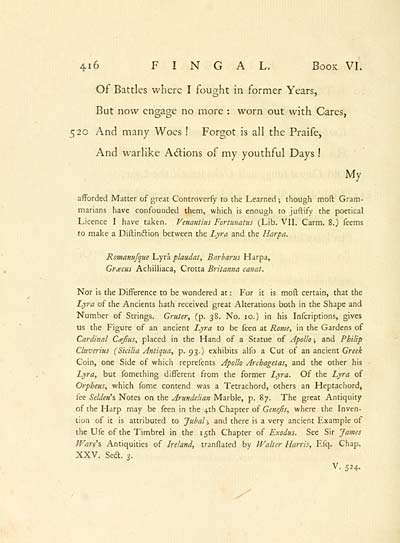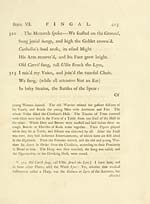Ossian Collection > Fingal of Ossian
(514)
Download files
Complete book:
Individual page:
Thumbnail gallery: Grid view | List view

4i6 F I N G A L. Book VI.
Of Battles where I fought in former Years,
But now engage no more : worn out with Cares,
520 And many Woes ! Forgot is all the Praife,
And warlike Adlions of my youthful Days !
My
afforded Matter of great Controverfy to the Learned ; though moft Gram-
marians have confounded them, which is enough to juftify the poetical
Licence I have taken. Venantius Fortimatus (Lib. VII. Carm. 8.) feems
to make a Diftindion between the Lyra and the Harpa.
Romanufque Lyra plaudat, Barbarus Harpa,
Gracus Achilliaca, Crotta Britanna canat.
Nor is the Difference to be wondered at : For it is moft certain, that the
Lyra of the Ancients hath received great Alterations both in the Shape and
Number of Strings. Gruter, (p. 38. No. 10.) in his Infcriptions, gives
us the Figure of an ancient Lyra to be feen at Rome, in the Gardens of
Cardinal Cafius, placed in the Hand of a Statue of Apollo \ and Philip
Cltiverius (Sicilia Antiqtia, p. 93.) exhibits alfo a Cut of an ancient Greek
Coin, one Side of which reprefents Apollo Archagetas, and the other his
Lyra, but fomething different from the former Lyra. Of the Lyra of
Orpheus, which Ibme contend was a Tetrachord, others an Heptachord,
fee Selden's Notes on the Arundelian Marble, p. 87. The great Antiquity
of the Harp may be feen in the 4th Chapter of Gene/ts, where the Inven-
tion of it is attributed to Jubal; and there is a very ancient Example of
the Ufe of the Timbrel in the 15th Chapter of Exodus. See Sir James
JVart's Antiquities of Ireland, tranflated by IValter Harris, Efq. Chap.
XXV. Sea. 3.
V. 524.
Of Battles where I fought in former Years,
But now engage no more : worn out with Cares,
520 And many Woes ! Forgot is all the Praife,
And warlike Adlions of my youthful Days !
My
afforded Matter of great Controverfy to the Learned ; though moft Gram-
marians have confounded them, which is enough to juftify the poetical
Licence I have taken. Venantius Fortimatus (Lib. VII. Carm. 8.) feems
to make a Diftindion between the Lyra and the Harpa.
Romanufque Lyra plaudat, Barbarus Harpa,
Gracus Achilliaca, Crotta Britanna canat.
Nor is the Difference to be wondered at : For it is moft certain, that the
Lyra of the Ancients hath received great Alterations both in the Shape and
Number of Strings. Gruter, (p. 38. No. 10.) in his Infcriptions, gives
us the Figure of an ancient Lyra to be feen at Rome, in the Gardens of
Cardinal Cafius, placed in the Hand of a Statue of Apollo \ and Philip
Cltiverius (Sicilia Antiqtia, p. 93.) exhibits alfo a Cut of an ancient Greek
Coin, one Side of which reprefents Apollo Archagetas, and the other his
Lyra, but fomething different from the former Lyra. Of the Lyra of
Orpheus, which Ibme contend was a Tetrachord, others an Heptachord,
fee Selden's Notes on the Arundelian Marble, p. 87. The great Antiquity
of the Harp may be feen in the 4th Chapter of Gene/ts, where the Inven-
tion of it is attributed to Jubal; and there is a very ancient Example of
the Ufe of the Timbrel in the 15th Chapter of Exodus. See Sir James
JVart's Antiquities of Ireland, tranflated by IValter Harris, Efq. Chap.
XXV. Sea. 3.
V. 524.
Set display mode to: Large image | Transcription
Images and transcriptions on this page, including medium image downloads, may be used under the Creative Commons Attribution 4.0 International Licence unless otherwise stated. ![]()
| Early Gaelic Book Collections > Ossian Collection > Fingal of Ossian > (514) |
|---|
| Permanent URL | https://digital.nls.uk/77608531 |
|---|
| Description | Selected books from the Ossian Collection of 327 volumes, originally assembled by J. Norman Methven of Perth. Different editions and translations of James MacPherson's epic poem 'Ossian', some with a map of the 'Kingdom of Connor'. Also secondary material relating to Ossianic poetry and the Ossian controversy. |
|---|
| Description | Selected items from five 'Special and Named Printed Collections'. Includes books in Gaelic and other Celtic languages, works about the Gaels, their languages, literature, culture and history. |
|---|

